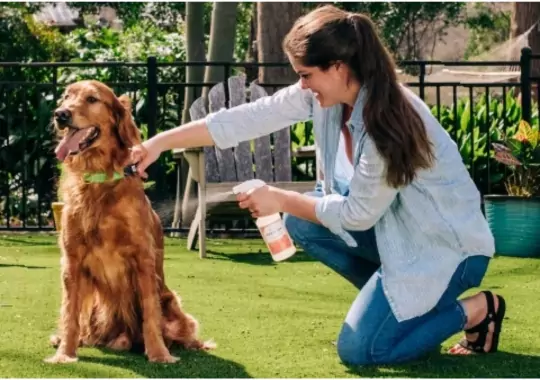As Amazon affiliates we may earn a commission if you purchase a product at no cost to you.
Ah, the joys of having a dog - those wagging tails, wet-nosed kisses, and unconditional love. But, it's not all sunshine and rainbows when your furry companion starts scratching and biting furiously, thanks to those tiny, blood-sucking menaces - fleas! So, you find yourself asking, "What kills dog fleas immediately?" Fear not, because we've got your back!
What are Fleas and Why Are They Such a Menace?
Fleas are like the uninvited guests at a never-ending party - you never wanted them around, but they're here to stay unless you show them the door. These minuscule, wingless insects feast on your dog's blood, causing discomfort, itching, and even allergies. They're tiny, but they sure pack a punch! Here's why they're such a menace:
- Flea Bites: Flea bites are itchy, and painful, and often lead to allergic reactions in dogs. That incessant scratching and biting? Blame it on these tiny terrors!
- Diseases: Fleas can transmit various diseases like tapeworms and Bartonella. That's more trouble than you'd ever want for your furry friend.
- Home Invasion: Once they've hitched a ride on your dog, fleas often make themselves at home in your carpets, bedding, and furniture. Your house becomes their playground!
- Reproduction Masters: Fleas are prolific breeders. One female flea can lay up to 50 eggs a day, and those eggs hatch into more fleas, turning your home into a flea nursery!
So, the million-dollar question remains - "What kills dog fleas immediately?" Let's dive into the solutions!

Immediate Flea-Killing Solutions
When dealing with fleas, you want results, and you want them now! Here are some strategies to eliminate those pests on the spot:
1. Flea Shampoo - A Bath-Time Game Changer!
Your dog deserves a spa day! Flea shampoos are designed to tackle those pesky fleas head-on. They often contain ingredients like pyrethrin, which can kill fleas on contact. Here's a highly-rated Flea Shampoo on Amazon.
2. Spot-On Treatments - The Topical Heroes
Spot-on treatments, also known as topical flea treatments, are like your dog's own superhero capes. Applied directly to your dog's skin, these treatments are a powerful method to kill fleas immediately. They work in various ways:
- They disrupt the flea's nervous system, making it go kaput.
- Some can inhibit flea eggs from hatching.
- They often provide month-long protection. Here's a top-rated Spot-On Treatment on Amazon.
3. Flea Collars - The Fashion Statement
Your dog deserves a spa day! Flea collars are not only a fashion statement but also a great way to kill fleas immediately. They release chemicals that kill fleas on contact and can offer protection for several months. Check out this effective Flea Collar on Amazon.
4. Flea Sprays - A Whole-House Solution
For an all-out flea assault, consider flea sprays. These can be used on your dog and throughout your home. The ones designed for dogs will kill fleas on contact and provide lasting protection. Here's a top-rated Flea Spray on Amazon.
5. Flea Combs - Good Ol' Manual Labor
Your dog deserves a spa day! Flea combs are like the detectives of the flea world. They help you identify and manually remove fleas from your dog's fur. While this method might not be as immediate as others, it's effective and chemical-free.

Long-Term Flea Control Strategies
While immediate solutions work wonders, it's also essential to have a plan for long-term flea control. You don't want those pesky pests making a comeback! Here's what you can do:
1. Regular Grooming - Keep Things Tidy
Grooming your dog regularly is not just about fluffing their fur; it's also about keeping an eye out for fleas. The sooner you spot them, the sooner you can get rid of them!
2. Keep Your Home Clean - A Flea-Free Zone
Fleas are not picky. They'll infest your carpets, furniture, and bedding as readily as your dog. Regularly vacuuming, washing bedding, and using flea sprays can help maintain a flea-free home.
3. Treat Your Yard - The Great Outdoors
Fleas can lurk in your yard, waiting to pounce on your dog. Use outdoor flea treatments or hire a professional pest control service to ensure your yard is flea-free.
4. Preventive Measures - Better Safe Than Sorry
Once you've got rid of fleas, don't let them back in! Continue using preventive flea treatments, such as spot-on treatments, to ensure your dog remains flea-free.
Recommended Article

Frequently Asked Questions FAQs
Are there natural remedies to kill fleas immediately?
Yes, several natural remedies can help. These include using essential oils like lavender and cedarwood, diatomaceous earth, and even a mixture of water and dish soap in a shallow dish with a light above it at night to attract and trap fleas.
Can I use human flea products on my dog?
It's generally not recommended. Human products might contain chemicals that are safe for humans but toxic to dogs. Always use products designed specifically for your furry friend.
Can fleas survive on my dog all year round?
Fleas can survive year-round in warm climates but might be less active during the winter months. However, in colder regions, fleas often go dormant during the winter, waiting for the warmth to return.
Can I prevent fleas in the first place?
Absolutely! Regular grooming, keeping your dog's bedding and environment clean, and using preventive treatments like monthly spot-on treatments can help keep fleas at bay.
Conclusion
So, "What kills dog fleas immediately?" As we've discovered, there's a whole arsenal of options at your disposal to deal with these tiny terrors. From flea shampoos and spot-on treatments to flea collars and sprays, you have the power to eliminate fleas on the spot. But remember, it's not just about immediate solutions; it's also about long-term control.










